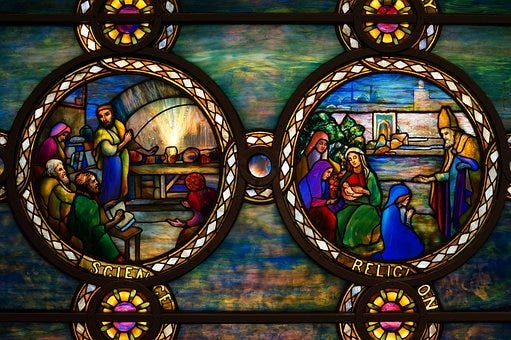
The idea of bringing science and religion together has been an ongoing idea of mine for some time. It is all part of the search for a new paradigm, a new scientific and philosophical way of understanding the universe, which may be an essential ingredient in our attempts to save the planet.
I’ve been invited to give a talk on this theme on June 9th (2019) in Leeds (England). I’ll publish the full transcript nearer the time, but in the coming months, as part of my preparations, I’ll post related material, mainly the stuff from my research that won’t find its way into the talk.
Creating a synthesis of science and religion would be desirable in itself. But why do I say a reunification, not merely a unification? It’s not just that people in earlier times did not make this distinction, using the term natural philosophy, and that it is only since the Enlightenment that science and religion have been separated. It’s also because ancient cultures had a very sophisticated understanding of scientific issues. Such a synthesis would therefore be a rediscovery of an Ancient Wisdom, which arguably remains more advanced than modern scientific thinking. It would undoubtedly come as a shock to ‘Enlightenment’ scientists that they still haven’t caught up with this Ancient Wisdom.
Some interesting books on this theme are:
- Ancient Wisdom and Modern Science by Stanislav Grof, as editor (1). In his introduction he describes the problem in detail (by ‘perennial philosophy’ he means the Ancient Wisdom):
“A tendency to glorify progress and evolution and to look down upon the past as a time of infancy and immaturity is associated with the view that the ideological and cultural differences between East and West are absolute and unbridgeable”. He refers to “the fundamental difference in their dominant world-views and philosophies. Western scientific disciplines have described the universe as an infinitely complex mechanical system of interacting, discrete particles and separate objects. In this context, matter appears to be solid, inert, passive and unconscious; life, consciousness and creative intelligence are seen as insignificant accidents and derivatives of material development. They emerged after billions of years of random mechanical evolution of matter and only in a negligible section of an immense universe.
“In contrast, the spiritual philosophies of the great ancient and Eastern cultures — or ‘perennial philosophy’ — describe consciousness and creative intelligence as primary attributes of existence, both transcendent and immanent in the phenomenal world. Western science recognizes as real only those phenomena that can be objectively observed and measured; perennial philosophy acknowledges an entire hierarchy of realities — some of them manifest, others hidden under ordinary circumstances and directly observable only in certain special states of consciousness.
“Materialistic science and perennial philosophy differ most in their images of human nature. Western science portrays human beings as highly developed animals and thinking biological machines who have a fleeting, insignificant role in the overall scheme of things. Perennial philosophy sees humans as essentially commensurate with the entire universe and ultimately divine”.
Grof later asks whether Western science and perennial wisdom could be “reconciled in a way that would combine their advantages and avoid their drawbacks. Since it is not possible to change the ancient and perennial, any attempt at such synthesis must involve changes in the philosophy of Western science. But is it possible to change the basic assumptions of science while preserving its formidable pragmatic powers? Do not the everyday triumphs of mechanistic science constitute a clear proof of the accuracy of its basic philosophical assumptions?”
- Creating the Soul Body: the Sacred Science of Immortality by Robert E. Cox (2). The connection with my theme may not be apparent from the title, but this is his opening statement: “This book is devoted to a re-evaluation of ancient systems of religious-mythological thought and their relevance to our modern systems of scientific thought. Throughout this book runs this theme: The ancients were much more intelligent than we have supposed them to be. In particular, the chapters that follow propose that many ancient cultures once shared a genuine spiritual science, a science of consciousness, which in certain ways rivals and even surpasses the most advanced physical theories of today”.
- The Snake and the Rope: Problems in Western Science Resolved by Occult Science by Edi D. Bilimoria (3).
Quantum physics is the most important factor in this reunification of science and religion. Bilimoria calls it the crown jewel of modern physics (I would also say of modern science). My previous posts on quantum physics (4) are therefore relevant to this ongoing theme of reunification. Bilimoria also says that it was predated by occult science for centuries.
I’ll be returning to all these themes in future posts.
Footnotes:
(1) State University of New York Press, Albany, 1984
(2) Inner Traditions, 2008
(3) Theosophical Publishing House, 2006